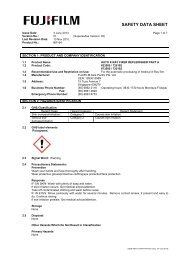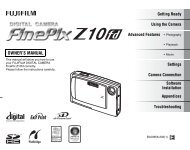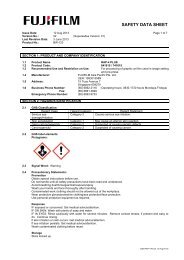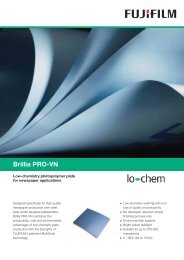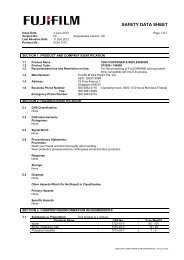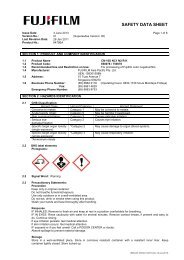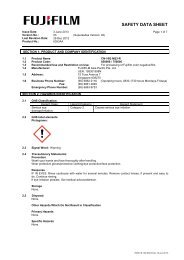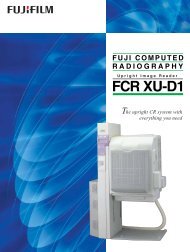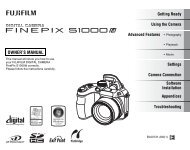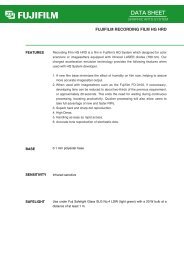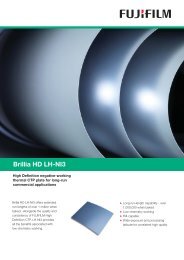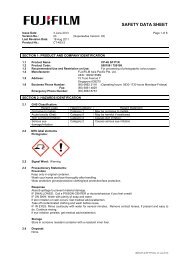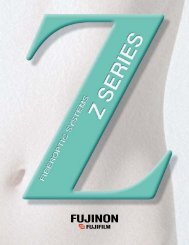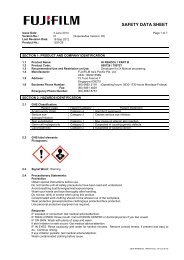FUJICHROME Sensia 200 [RM]
FUJICHROME Sensia 200 [RM]
FUJICHROME Sensia 200 [RM]
You also want an ePaper? Increase the reach of your titles
YUMPU automatically turns print PDFs into web optimized ePapers that Google loves.
1. FEATURES AND USES<br />
<strong>FUJICHROME</strong> <strong>Sensia</strong> <strong>200</strong> [<strong>RM</strong>] is a high-image-quality,<br />
daylight ISO <strong>200</strong> color reversal film which features extremely<br />
fine grain and sharpness, as well as faithful and<br />
brilliant color reproduction and rich tones ranging from<br />
the brightest highlights to the deepest shadows. These<br />
qualities make this film an excellent choice not only for<br />
normal outdoor photography but also for a wide variety<br />
of indoor scenes and situations requiring high shutter<br />
speeds.<br />
<strong>Sensia</strong> <strong>200</strong> is ideally suitable for slide projection and for<br />
making big enlargements, as well as for printing on<br />
<strong>FUJICHROME</strong> paper and making high-quality duplicates<br />
using duplicating film.<br />
Features Results<br />
• Ultra-fine Grain /<br />
High Resolution<br />
• Faithful and<br />
Brilliant Color<br />
Reproduction<br />
• Rich Tone<br />
Reproduction<br />
• Superior<br />
Reciprocity<br />
Characteristics<br />
• Ideal Slide Projection<br />
Suitability<br />
• E-6 / CR-56*<br />
Processing<br />
• Refined images ideal for<br />
large-size enlargements<br />
and other high-magnification<br />
applications, as a<br />
result of its extremely fine<br />
grain<br />
• ISO-100 film-level performance<br />
giving more faithful<br />
color reproduction and<br />
higher color saturation<br />
than any previous ISO<br />
<strong>200</strong>-speed film<br />
• Smooth and continuous<br />
gradation linearity from the<br />
highlights to the shadows<br />
assuring delicate texture<br />
and rich tone reproduction<br />
• Minimal long-exposurerelated<br />
loss in film speed<br />
and changes in color as a<br />
result of improved silver<br />
halide emulsion<br />
• Clear, fine-grain, delicately<br />
textured images with natural<br />
and brilliant colors, perfect<br />
for projection<br />
• As with other<br />
<strong>FUJICHROME</strong> film, worldwide<br />
processing available<br />
using E-6 / CR-56<br />
* CR-56 (Fujifilm) is equivalent to E-6 processing.<br />
AF3-080E<br />
COLOR REVERSAL FILMS<br />
<strong>FUJICHROME</strong> <strong>Sensia</strong> <strong>200</strong> [<strong>RM</strong>]<br />
2. SPEEDS<br />
Light Source<br />
* Indicates the effective speed resulting from designated filter<br />
use.<br />
** Wratten Filter<br />
*** Fuji Light Balancing Filter<br />
3. FILM SIZES, EMULSION NUMBER,<br />
BASE MATERIAL AND THICKNESS<br />
Sizes Emulsion Number<br />
Rolls:<br />
135 .......... 24-, 36-exp. #951 –<br />
Base Material ............ Cellulose Triacetate<br />
Base Thickness ........ 127 µm<br />
4. EXPOSURE GUIDE FOR VARIOUS<br />
LIGHT CONDITIONS<br />
Use a meter for exposure determination. If a meter is<br />
not available, refer to the following table.<br />
Daylight Exposure<br />
Light<br />
Conditions<br />
Daylight<br />
Tungsten Lamps<br />
(3<strong>200</strong>K)<br />
Lens<br />
Aperture<br />
Shutter<br />
Speed (Sec.)<br />
f/16<br />
1/500<br />
Speed<br />
ISO <strong>200</strong>/24°<br />
ISO 64*/19°*<br />
Seashore or<br />
Cloudy<br />
Snow Scenes Bright Hazy Cloudy Day or<br />
Under Bright Sunlight Sunlight Bright Open<br />
Sun<br />
Shade<br />
f/16<br />
1/250<br />
f/11<br />
1/250<br />
Filter<br />
None<br />
No.80A**<br />
(LBB-12***)<br />
f/8<br />
1/250<br />
f/5.6<br />
1/250<br />
NOTES • The foregoing settings are for 2 hours after sunrise<br />
and 2 hours before sunset.<br />
• Provide a lens opening 1/2-stop smaller during the<br />
summer and 1/2-stop larger during the winter (except<br />
for snow scenes).<br />
• Excessively bright (or dark) or backlighted subjects<br />
may require plus (or minus) 1-stop lens opening adjustments.<br />
1
FUJIFILM DATA SHEET • <strong>FUJICHROME</strong> <strong>Sensia</strong> <strong>200</strong> [<strong>RM</strong>]<br />
Low Light Exposure<br />
Light<br />
Conditions<br />
Lens<br />
Aperture<br />
Shutter<br />
Speed (Sec.)<br />
2<br />
Fine Weather<br />
Daytime<br />
Indoor<br />
Scenes<br />
Indoor Scenes<br />
(Under<br />
Fluores- cent<br />
Light)<br />
f/2.8 to 4<br />
1/30<br />
Stage<br />
or Evening<br />
Snow Scenes<br />
Scenes<br />
NOTES Since light intensities for indoor scenes varies widely<br />
from location to location, the data above should be<br />
used only as a guide.<br />
Daylight<br />
Under normal daylight conditions, color balancing filters<br />
are not necessary, but the following exposure conditions<br />
may require the indicated filters.<br />
Subject Conditions<br />
Open shade in fair weather and<br />
shaded landscapes.<br />
Bright distant views, snow<br />
scenes, seaside locations,<br />
aerial shots and open<br />
landscapes.<br />
Close-ups of plants and<br />
subjects having bright colors.<br />
Filter<br />
UV Filter<br />
No.2C*<br />
(SC-39 or<br />
SC-40)**<br />
Exposure<br />
Correction<br />
None<br />
Excessively high or low subject color temperatures may<br />
require the following filters and exposure corrections.<br />
Subject Conditions<br />
High Color Temperature :<br />
Cloudy weather landscapes or<br />
portraits in open shade in clear<br />
weather.<br />
Low Color Temperature :<br />
Morning and evening twilight<br />
scenes and portraits.<br />
Filter<br />
No.81A*<br />
(LBA-2)***<br />
No.82A* or<br />
No.82C*<br />
(LBB-2 or<br />
LBB-4)***<br />
* Wratten Filters<br />
** Fuji Sharp-cut Filter<br />
*** Fuji Light Balancing Filter<br />
**** A "+" followed by a number indicates the required<br />
increase in lens opening.<br />
Exposure<br />
Correction<br />
+1/3<br />
stop****<br />
+1/3 to<br />
+2/3<br />
stop****<br />
Electronic Flash<br />
• Electronic flash produces light similar to daylight, so<br />
filters are not normally needed. However, the possibility<br />
of undesirable effects on color balance, due to<br />
various factors (differences in equipment, amount of<br />
use, etc.) should be taken into consideration. Test<br />
exposures are recommended.<br />
• The use of a flash meter is advisable, but the following<br />
formula can also be used to obtain a satisfactory<br />
lens opening.<br />
Lens<br />
Aperture =<br />
(f-number)<br />
Electronic Flash Guide Number<br />
(at ISO <strong>200</strong>)<br />
Electronic Flash-to-Subject Distance<br />
(meters)<br />
• Set the film speed at ISO <strong>200</strong>. Since the amount of<br />
light reflected onto the subject from surrounding surfaces<br />
will differ with the conditions, refer to the flash<br />
unit instructions.<br />
Daylight Photoflood / Photo-Reflector Lamps<br />
• Daylight-type photoflood or photo-reflector lamp output<br />
may be lower than that indicated by an exposure<br />
meter, so it is advisable to compensate for this by increasing<br />
exposure time or the lens opening. Whenever<br />
possible, test exposures are recommended.<br />
• Other factors requiring consideration when determining<br />
the exposure time are lamp configuration, use duration<br />
and line voltage, as they may affect lamp output<br />
and color balance<br />
Fluorescent Lamps<br />
• The use of the following combinations of color compensating<br />
filters is advisable when photographing<br />
under fluorescent lighting.<br />
• For exacting work, however, test exposures are recommended<br />
because lamp brand and age may affect<br />
light output and color balance.<br />
Fluorescent<br />
Lamp Type<br />
Color Compensating<br />
Filters*<br />
Exposure<br />
Corrections**<br />
White<br />
(W)<br />
25M<br />
+2/3<br />
Daylight<br />
(D)<br />
30R+10M<br />
+1 1/3<br />
Cool White<br />
(CW)<br />
30M<br />
+1<br />
Warm White<br />
(WW)<br />
No.80B+<br />
10M + 10R<br />
+2<br />
(Exposure time: 1/2 second)<br />
* Kodak Color Compensating Filters (or Fuji CC Filters) are recommended.<br />
** Exposure correction values include filter exposure factors.<br />
These values are added to normal exposure meter readings.<br />
A "+" followed by a number indicates the required increase in<br />
lens opening.<br />
NOTES • Use a shutter speed slower than 1/30 second.<br />
• For shutter speeds of 64 seconds or more, exposure<br />
adjustments will be necessary to compensate<br />
for reciprocity-related failure.<br />
Tungsten Lamps<br />
• A Wratten Filter No.80A (or Fuji Light Balancing Filter<br />
LBB-12) is required when using 3<strong>200</strong>K tungsten<br />
lighting. A 1 2/3-stop larger lens opening is also<br />
required.<br />
• With household tungsten lamps, a Wratten Filter<br />
No.82A (or Fuji Light Balancing Filter LBB-2) will<br />
compensate for the lower color temperature. A 2stop<br />
larger lens opening is required.
Mixed Light Sources<br />
Under mixed light conditions, the basic filter configuration<br />
should suit the main light source. In the case of<br />
cameras with TTL metering, there is no need for additional<br />
exposure compensation for any CC filter(s) used.<br />
5. LONG EXPOSURE COMPENSATION<br />
No exposure correction or color balance compensation<br />
is required for exposures within a shutter speed range<br />
of 1/4000 second to 32 seconds. However, for exposures<br />
of one minute or longer, reciprocity-related color<br />
balance and exposure compensations are required.<br />
Exposure Time<br />
Color Compensating<br />
Filter<br />
Exposure<br />
Corrections*<br />
1/4000 – 32 sec. 1 min. 2 – 4 min.<br />
None<br />
8 min.<br />
Not<br />
recommended<br />
* Exposure correction values include filter exposure factors.<br />
These values are added to unfiltered exposure meter readings.<br />
A "+" followed by a number indicates the required increase in<br />
the lens opening.<br />
6. EXPOSURE PRECAUTIONS<br />
With artificial light, such as electronic flash, photoflood,<br />
fluorescent, tungsten, mercury vapor, etc., the lamp<br />
output and color temperature may be affected by such<br />
factors as brand, age of equipment and line voltage.<br />
Reflectors and diffusers can also influence light intensity<br />
and color temperature.<br />
7. FILM HANDLING<br />
• Expose film before the expiration date indicated on<br />
the film package and process as soon as possible<br />
after exposure.<br />
• When loading and unloading roll film, avoid direct<br />
sunlight. If there is no shade, shield the film from<br />
the sun with your body.<br />
• X-ray equipment used to inspect carry-on baggage<br />
at airport terminals can cause film fogging. Both<br />
exposed and unexposed films should be removed<br />
for manual inspection.<br />
• Film fogging may occur near X-ray equipment used<br />
in hospitals, factories, laboratories and other locations.<br />
Always keep film away from possible<br />
sources of radiation.<br />
5G<br />
+2/3<br />
7.5G<br />
+1<br />
<strong>FUJICHROME</strong> <strong>Sensia</strong> <strong>200</strong> [<strong>RM</strong>] • FUJIFILM DATA SHEET<br />
8. FILM STORAGE<br />
Unprocessed Film<br />
• Storing exposed or unexposed film under hot and<br />
humid conditions may adversely affect the speed,<br />
color balance and physical properties of the film.<br />
Store film under the following conditions.<br />
⎧<br />
⎪<br />
⎨<br />
⎪<br />
⎩<br />
O Short-to-medium-term storage :<br />
Below 15°C (59°F) ........ (Refrigerator)<br />
O Long-term storage :<br />
Below 0°C (32°F) .......... (Freezer)<br />
• Building materials, finishes used on newly manufactured<br />
furniture, paints and bonding agents may<br />
produce gases which could affect photographic<br />
film. Do not store film, lightproof boxes of film,<br />
loaded cameras or film holders near these materials.<br />
• Before use, films taken from cold storage should be<br />
allowed to stand at room-temperature for over 3<br />
hours for refrigerated film, and over 6 hours for frozen<br />
film.<br />
Processed Film<br />
Exposure to light, high temperature and humid conditions<br />
can cause color changes in processed films.<br />
Therefore, place such films in mounts or sleeves and<br />
store them in a dark, dry, cool and well ventilated location<br />
under the following conditions.<br />
⎧<br />
⎪<br />
⎨<br />
⎪<br />
⎩<br />
O Medium-term storage:<br />
Below 25°C (77°F) at 30% to 60% RH<br />
O Long-term storage :<br />
Below 10°C (50°F) at 30% to 50% RH<br />
NOTE As with all color dyes, those used in this film will discolor<br />
or fade with time.<br />
9. PROCESSING<br />
This film is designed for processing by Kodak E-6,<br />
Fujifilm CR-56, or equivalent chemicals.<br />
10. LIGHT SOURCES FOR VIEWING<br />
Take care to use a standard viewer, as visual responses<br />
differ with light source quality and brightness.<br />
11. PRINTS<br />
Slides can be made into normal prints on <strong>FUJICHROME</strong><br />
paper or into Super Digital Prints.<br />
3
FUJIFILM DATA SHEET • <strong>FUJICHROME</strong> <strong>Sensia</strong> <strong>200</strong> [<strong>RM</strong>]<br />
4<br />
12. PROCESSED FILM EDGE MARKINGS<br />
• 135 Size<br />
13. FILM STRUCTURE<br />
* These layers become colorless and transparent after processing.<br />
14. DIFFUSE <strong>RM</strong>S GRANULARITY VALUE ............ 13<br />
Micro-densitometer Measurement Aperture : 48 µm in diameter<br />
Sample Density : 1.0 above minimum density<br />
15. RESOLVING POWER<br />
Chart Contrast 1.6 : 1 ............ 60 lines/mm<br />
Chart Contrast 1000 : 1 .......... 140 lines/mm
<strong>FUJICHROME</strong> <strong>Sensia</strong> <strong>200</strong> [<strong>RM</strong>] • FUJIFILM DATA SHEET<br />
16. CHARACTERISTIC CURVES 17. SPECTRAL SENSITIVITY CURVES<br />
* Sensitivity equals the reciprocal of the exposure (J/cm 2 )<br />
required to produce a specified density.<br />
18. MTF CURVE 19. SPECTRAL DYE DENSITY CURVES<br />
5
FUJIFILM DATA SHEET • <strong>FUJICHROME</strong> <strong>Sensia</strong> <strong>200</strong> [<strong>RM</strong>]<br />
6<br />
NOTICE The data herein published were derived from materials taken from<br />
general production runs. However, as Fujifilm is constantly upgrading the quality of<br />
its products, changes in specifications may occur without prior notice.<br />
FUJI PHOTO FILM CO., LTD.<br />
26-30, Nishiazabu 2-chome, Minato-ku, Tokyo 106-8620, Japan<br />
Ref. No. AF3-080E (EIGI-00.8-HB•10-1●) Printed in Japan


![FUJICHROME Sensia 200 [RM]](https://img.yumpu.com/20881156/1/500x640/fujichrome-sensia-200-rm.jpg)
